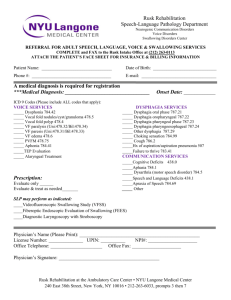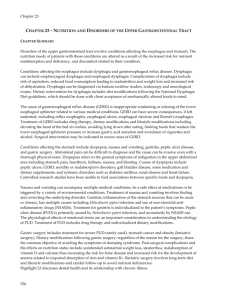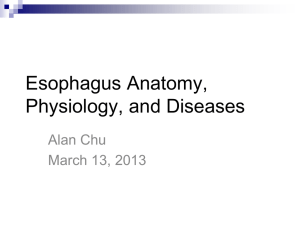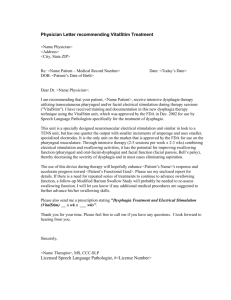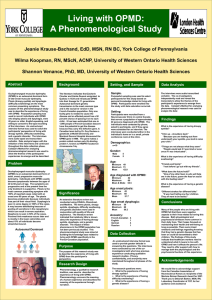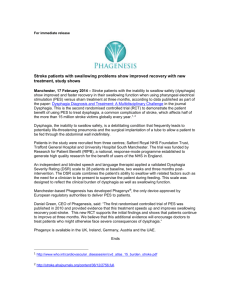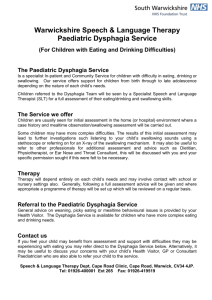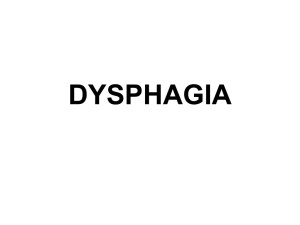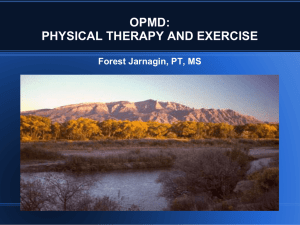Dysphagia and OPMD: More than an
advertisement
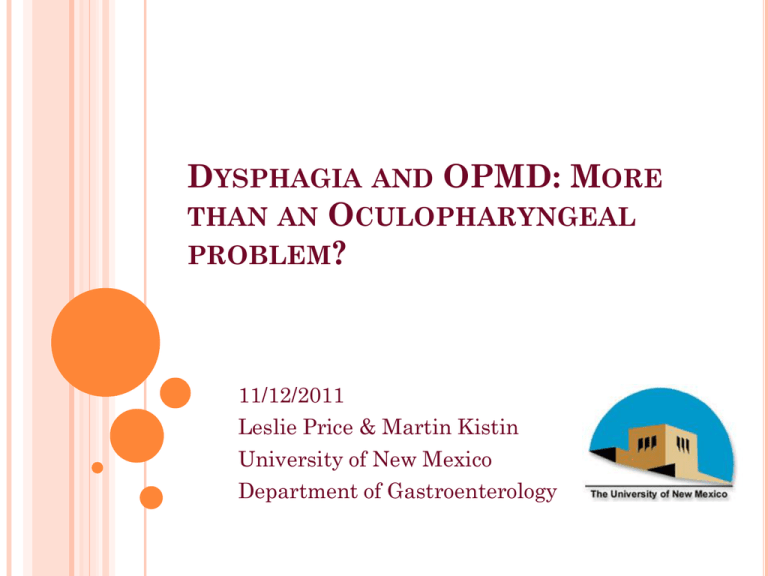
DYSPHAGIA AND OPMD: MORE THAN AN OCULOPHARYNGEAL PROBLEM? 11/12/2011 Leslie Price & Martin Kistin University of New Mexico Department of Gastroenterology OVERVIEW Background Normal swallowing review Dysphagia & OPMD (difficulties swallowing) Tests and evaluation Treatment options BACKGROUND Late onset hereditary myopathy Inherited disease (passed from generation to generation) Characterized by progressive ptosis (weakness of the eyelids) Dysphagia (difficulties swallowing) Limb weakness Doesn’t shorten life but may change the way people live BACKGROUND OPMD in New Mexico 216 patients Symptoms Ptosis: 190 (88%) Dysphagia: 127 (59%) Onset Ptosis before dysphagia: 20 (43%) Ptosis and dysphagia together: 20 (43%) Dysphagia before ptosis: 7 (14%) Mean onset of symptoms Ptosis: 52 years of age Dysphagia: 54 years of age Proximal weakness: 63 years of age Becher et al. Oculopharyngeal Muscular Dystrophy in Hispanic New Mexicans. JAMA. 2001; 286: 2437-2440. WHAT HAPPENS WHEN WE EAT? Ingest food into our mouth and hold it Initiate a swallow and move the food to the back of the throat A flap/epiglottis covers the wind pipe/trachea to prevent food from entering the trachea and lungs (aspiration) A valve at the top of the esophagus (upper esophageal sphincter) opens to allow food into the esophagus DYSPHAGIA – CLINICAL FEATURES Progressive oropharyngeal muscle weakness Manifests with increased time to eat meals and avoidance of dry and solid foods With progression, fluids may become difficult to swallow End stage: characterized by aspiration, malnutrition, and weight loss Oral Tongue weakness if observed Muscles too weak to hold food or push bolus to back of throat Manjaly et al. Cricopharyngeal dilatation for the long-term treatment of dysphagia in OPMD. Dysphagia 2011 Jul 30: Epub ahead DYSPHAGIA – CLINICAL FEATURES Pharynx Muscles may be too weak to get food into esophagus and food may “pool” in little pockets Muscles of eppiglotis may be too weak to protect voice box and trachea (aspiration) Soft palate may not keep food out of nasal cavity DYSPHAGIA – CLINICAL FEATURES Esophagus The valve at the top end of the esophagus (upper esophageal sphincter) may be too thick and may not open to let food pass into the esophagus Older studies suggest that esophageal motility is impaired UNM retrospective study: self reported heartburn 1 Tiomny et al. Esophageal smooth muscle dysfunction in OPMD. Dig Dis Sci 1996; 41: 1350-1354. Castell et al. Manometric characteristics of the pharynx, upper esophageal sphincter, esophagus, and lower esophageal sphincter in patients with OPMD. Dysphagia 1995; 10: 22-26. 2 UPPER ESOPHAGEAL SPHINCTER Inferior pharyngeal constrictor Cricopharyngeus muscle Cervical esophagus TESTS FOR SWALLOWING Speech Pathology Video Barium Swallow UGI Endoscopy Esophageal manometry/motility with impedance BARIUM SWALLOW BARIUM SWALLOW First test for dysphagia Can identify transfer problems Can tell if food goes down the trachea Can tell if the upper esophageal sphincter doesn’t relax to allow food into the esophagus Look for blockage BARIUM SWALLOW – COMMON FINDINGS Barium/food leaks from mouth or nose (nasal/oral regurgitation) Multiple swallows required to move barium/food from the mouth to the throat and esophagus Barium/food stays (“pools”) in throat and doesn’t get into esophagus Throat muscles seem weak Barium/Food gets past flap into voice box or trachea Muscles of the upper esophageal sphincter are too thick and don’t allow food to pass ESOPHAGEAL MANOMETRY AND IMPEDANCE Measures the pressures in the throat and esophagus Usually done without sedation TREATMENT Treatment (alteration of the cricopharyngeus muscle anatomy and function) Cricopharyngeal myotomy (surgery) Botox injection (powerful nerve toxin injected to induce muscle relaxation) Esophageal dilation Dietary changes: Smaller meals Soft, ground diet Liquids via cup Allow more time to swallow Alternate solids and liquids Eat sitting upright Remain upright after meals 30-60 minutes Head flex/Chin tuck CRICOPHARYNGEAL MYOTOMY First reported by Peterman in 1964 Fully described by Montgomery and Lynch in 1971 Technique: division of entire inferior pharyngeal constrictor muscle, cricopharyngeus muscle, and the upper part of the circular fibers of the cervical esophagus Hypothesis: remove obstruction made by constrictive UES that cannot be overcome by decreased pharyngeal propulsion Retrospective study of 37 patients from 1980 to 1995 Mean follow-up 6.2 years: Totally relieved or rarely occurring symptoms: 18/37 (49%) Moderate symptoms/partial: 12/37 (32%) Severe symptoms/failure: 7/37 (19%) Follow-up at 8 years: Nearly all patients had recurrence of swallowing and tracheobronchial symptoms Fradet et al. Upper esophageal sphincter myotomy in OPMD: long-term clinical results. Neuromusc Disorders 7 Suppl 1997; S90-S95. CRICOPHARYNGEAL MYOTOMY Retrospective study of 22 patients from 1987 to 1995 12 patients underwent cricopharyngeal myotomy Mean follow-up 29.6 months Improvement: 10 patients Partial improvement: 1 patient No improvement: 1 patient Factors associated with favorable outcome were residual pharyngeal propulsion and no weight loss Conclusion: Cricopharyngeal myotomy is an effective treatment of dysphagia with adequate residual propulsion but does not modify the final prognosis and is contraindicated in cases with pharyngeal aperistalsis Perie et al. Dysphagia in OPMD: a series of 22 French cases. Neuromusc Disorders 7 Suppl 1997; S96-S99. BOTOX Injection of powerful neurotoxin produced by Clostridium botulinum Limited to cases Limitations/side effects: Temporary Dysphonia Aspiration DILATION PROCEDURE Conscious sedation: light sleep Endoscopy evaluation of esophagus, stomach, and small intestine A wire is passed through the scope and positioned in the stomach. The scope is removed and exchanged with the wire A savory dilator is passed over the wire to stretch the cricopharyngeus muscle RECENT DILATION STUDY Retrospective study from 1995-2007 9 patients Dilation performed using 54Fr SavaryGilliard bougie Symptom severity prior to dilation and at follow-up (1, 4, and 12 months) was evaluated using the Sydney Swallow Questionnaire (SSQ) Median total treatment dilation period: 13 years Median number of dilatations per patient: 7.2 Median interval between treatments: 15 months Manjaly et al. Cricopharyngeal dilatation for the long-term treatment of dysphagia in OPMD. Dysphagia 2011 Jul 30: Epub ahead RECENT DILATION STUDY Mean SSQ prior to dilation: 1108.11 Mean SSQ at last follow-up: 297.78 (73% decrease); p= 0.0001 Interview was performed an average of 4.57 months after the most recent dilation (range 3-8 months) Conclusion: Repeated cricopharyngeal dilation is a safe, effective, welltolerated and long-lasting treatment for dysphagia in OPMD Manjaly et al. Cricopharyngeal dilatation for the long-term treatment of dysphagia in OPMD. Dysphagia 2011 Jul 30: Epub ahead PRIOR UNM STUDY Retrospective study OPMD patients seen in UNM GI, ENT, Neurology Diagnosis of OPMD with or without genetic confirmation Results: 100 patients Mean age 59 Dysphagia: 78% Mean age of onset 55 Progressive: 83% Weight loss: 21% Heartburn – self-reported in 45% PRIOR UNM STUDY Results: Prolonged meals and increased symptoms with solids: 90% Choking spells:75% Pill dysphagia: 25% Dysphagia treatment: Savory dilation: 20 patients 2 minor complications – dyspnea, epigastric pain Botox: 12 patients 5 minor complications – dysphonia, hoarseness, soreness Savory dilation and Botox: 8 patients PRIOR UNM STUDY Results: 82% improved with dilation 66% improved with Botox treatment No significant difference between the treatments (p=0.4) No significant difference in complications between the treatments (p=0.09) PROSPECTIVE UNM STUDY Assess esophageal dysphagia via modern high-resolution manometry We plan to combine manometry with pH/impedance to determine if patients experience acid or non-acid reflux Are there esophageal disorders we should be treating? Do OPMD patients benefit from treatment of GERD We hope to obtain more information regarding the role of dilation for OPMD patients 54Fr dilation followed by 60Fr dilation if no improvement or recurrence of symptoms REFERENCES Becher et al. Oculopharyngeal Muscular Dystrophy in Hispanic New Mexicans. JAMA. 2001; 286: 2437-2440. Manjaly et al. Cricopharyngeal dilatation for the long-term treatment of dysphagia in OPMD. Dysphagia 2011 Jul 30: Epub ahead Tiomny et al. Esophageal smooth muscle dysfunction in OPMD. Dig Dis Sci 1996; 41: 1350-1354. Bender MD. Esophageal manometry in oculopharyngeal dystrophy. Am J Gastroenterol. 1976 Mar; 65(3):215-21. Duranceau et al. Oculopharyngeal dysphagia in patients with OPMD. Can J Surg. 1978 Jul; 21 (4):326-9. Castell et al. Manometric characteristics of the pharynx, UES, esophagus, and LES in patients with OPMD. Dysphagia. 1995 Winter; 10(1):22-6. Fradet et al. Upper esophageal sphincter myotomy in OPMD: long-term clinical results. Neuromusc Disorders 7 Suppl 1997; S90-S95. Perie S et al. Dysphagia in OPMD: a series of 22 French cases. Neuromuscul Disord 1997 Oct; 7 Suppl 1: S96-9. Taillefer et al. Manometric and radionuclide assessment of pharyngeal emptying before and after cricopharyngeal myotomy in patients with OPMD. J thorac Cardiovasc Surg1988; 95: 868-875. QUESTIONS?
